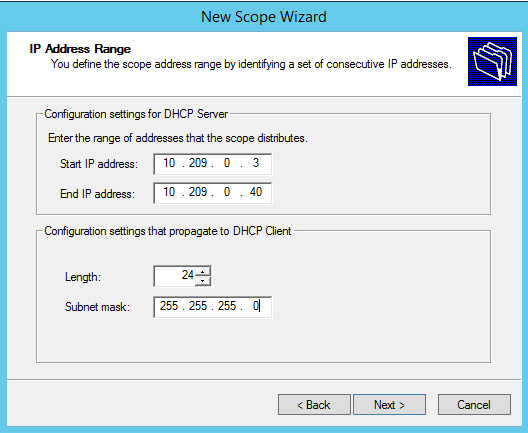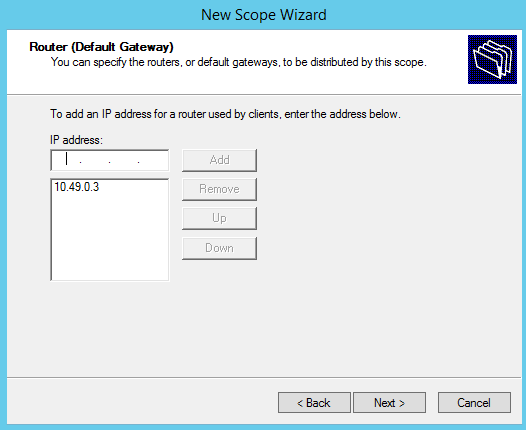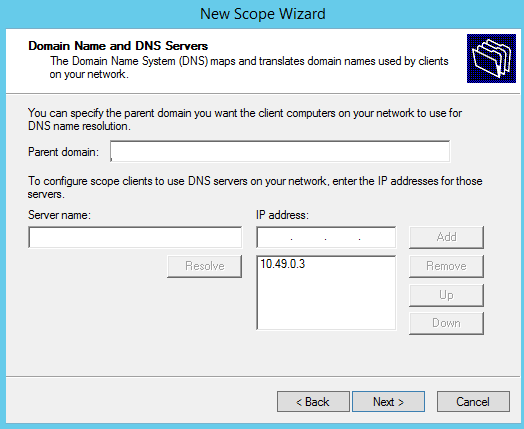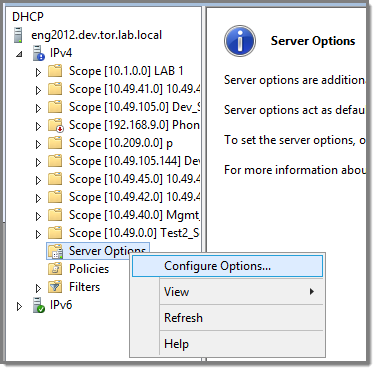Configuring Option 78
-
Click .
-
In the console tree, right-click the DHCP server,
IPv4 on which you want to create the new DHCP scope, and then click New Scope.
-
Click Next.
-
In the Name and Description text boxes, type the scope name and
description.
This can be any name that you want, but it should be descriptive enough so
that you can identify the purpose of the scope on your network.
-
Click Next.
The
IP Address Range window is
displayed.
-
In the Start IP address and the End IP address text boxes, type the start and
end of the IP address range that you want to be distributed to the network.
You must use the range provided by your network administrator.
-
In the Length text box, type the numeric value of the subnet mask bits, or in
the Subnet mask text box, type the subnet mask IP address.
A subnet mask defines how many bits of an IP address to use for the
network/subnet IDs and how many bits to use for the host ID. You can specify the
subnet mask by length or as an IP address. You must use the Length (or the
Subnet mask) provided by your network administrator.
-
Click Next.
The Add Exclusions window displays.
-
In the Start IP address and the End IP address text boxes, type the start and
end of the IP address range that you want to exclude from the
distribution.
You must use the exclusion range provided by your network
administrator.
-
Click Next.
The Lease Duration window displays.
The DHCP server assigns a client an IP address for a given amount of time.
The amount of time for which the IP address can be leased is defined in the
Lease Duration window.
-
In the Days, Hours and Minutes text box, type the lease duration.
You must use the Lease Duration as specified by your network
administrator.
-
Click Next.
The Configure DHCP Options window
displays.
-
Select Yes, I want to configure these options now, and
then click Next.
The Router (Default Gateway) window
displays.
-
In the IP address text box, type the network‘s
default gateway and click Add.
You must use the default gateway provided
by your network administrator.
-
Click Next.
The
Domain Name and DNS
Servers window displays.
Domain Name and DNS Servers
-
In the Parent domain text box, type your company‘s domain name.
You must use the Parent Domain provided by your network administrator.
-
In the Server name text box, type your server name.
You must use the server name provided by
your network administrator.
-
In the IP address text box, type your server‘s IP address, and then click
Add.
-
Click Next.
The WINS Servers window displays.
-
Click Next.
The Activate Scope window displays.
-
Select Yes, I want to activate this scope now, and click
Next.
The wizard displays the
following message:
You have successfully completed the New Scope wizard.
-
Click Finish.
-
Click .
The DHCP console tree displays.
-
Right-click Server Options in the tree
and select Configure Options.
The Server Options dialog displays.
-
On the General tab, enable 078 SLP DA.
-
In the lower pane of the screen, type the dotted decimal values of the SLP DA‘s
IP address.
The Wireless APs use the SLP DA to discover the ExtremeWireless Appliance.
The mobility agents use the SLP DA to discover the mobility manager.

Note
If there is no SLP deployment on the enterprise
network, the ExtremeWireless Appliance is configured to act as a DA by default. If
you put the appliance's IP address(es) in a DHCP server for Option 78,
Wireless APs will interact with the appliance for discovery.
Similarly, the mobility agents also interact with the
ExtremeWireless Appliance to discover the mobility manager.




